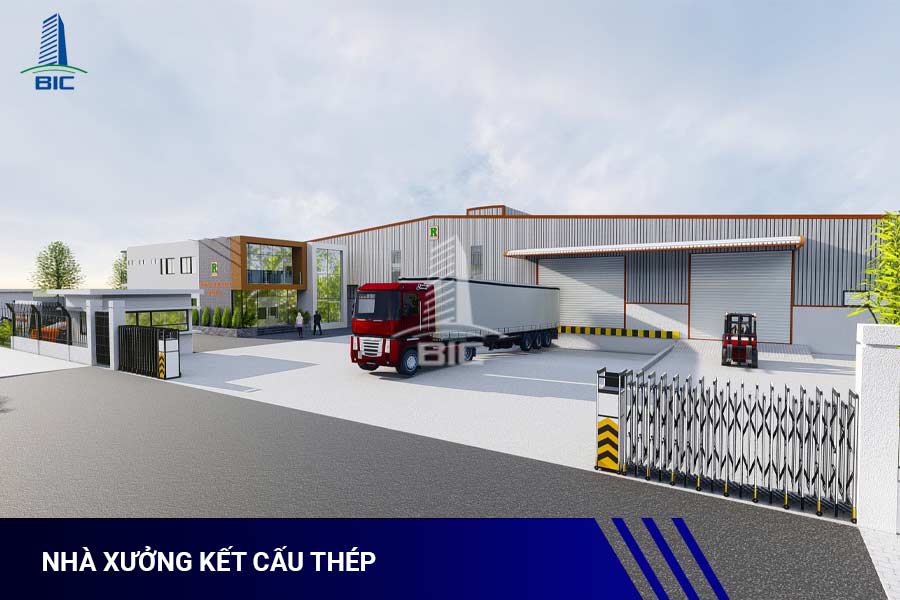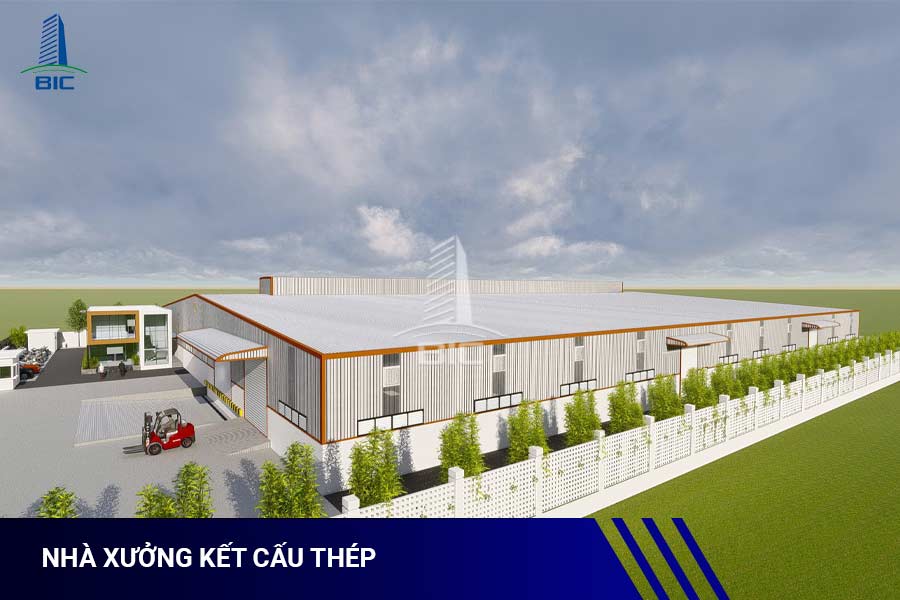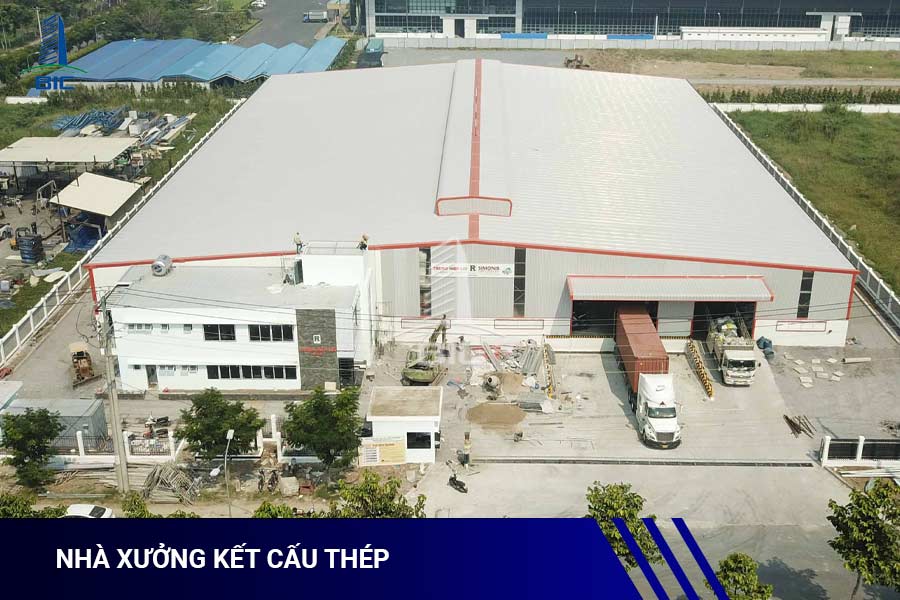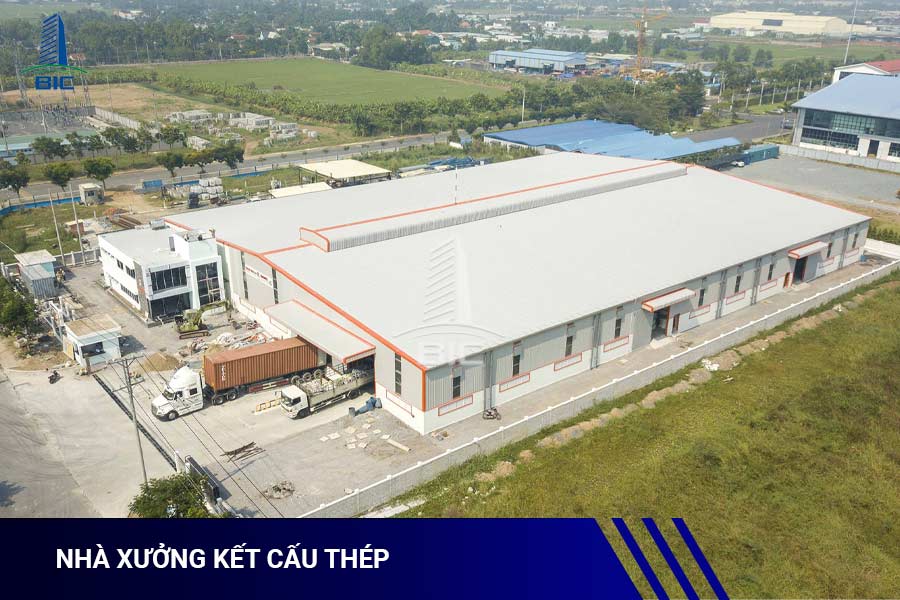
Steel structure factories are becoming the top choice in modern industrial construction thanks to their outstanding advantages in construction speed, investment cost, and flexibility in accommodating diverse types of production. The steel frames are prefabricated at the factory and quickly assembled on-site, helping businesses significantly shorten the time needed to put the facility into operation.
Compared to traditional concrete, steel structures are lighter, reducing foundation costs, while allowing easy expansion or renovation when needs change. During the design and construction process, this type of factory also provides spacious areas with fewer columns, making it convenient to arrange production lines, warehouses, and auxiliary facilities. This flexibility has made steel structures an effective solution, well-suited to the development requirements of many industries and logistics today.
A steel structure factory is an industrial facility whose main frame is made entirely of steel, including columns, trusses, purlins, and bracing systems. The steel components are designed and prefabricated at the factory, then transported to the construction site for assembly. This modern type of factory is increasingly popular due to its advantages in construction speed, load-bearing capacity, and design flexibility.

- Main frame: Includes steel columns and trusses (rolled or fabricated), bearing the entire roof and wind loads.
- Bracing and purlins: Ensure structural stability and reasonable load distribution.
- Cladding materials: Usually use corrugated steel sheets or insulated panels, lightweight and easy to install.
- Connections: Made with high-strength bolts or welds, ensuring durability and safety.
Compared to reinforced concrete, steel structure factories are lighter, easier to assemble, and more adaptable to changes. While concrete factories have advantages in longevity and insulation, they require longer construction times and are harder to modify. Therefore, many businesses prefer steel structures to both shorten schedules and maintain flexibility for expansion.
Thanks to prefabrication at the factory and direct on-site assembly, steel structure factories drastically reduce construction time compared to traditional methods. Businesses can put facilities into operation earlier, seize business opportunities faster, and shorten payback time.

Steel structures weigh less than reinforced concrete, reducing foundation loads and treatment costs. Moreover, precise fabrication at the factory minimizes material waste and labor costs on-site. In the long run, the facilities also save operating costs through integration with energy-efficient solutions.
Steel frames are designed to withstand heavy loads, suitable for industries using large machinery or modern production lines. With anti-corrosion coatings, facilities maintain durability for decades and resist storms, vibrations, or harsh climates.
Steel structures allow for wide spaces with fewer interior columns, making it easy to arrange production lines, storage areas, or office sections. When requirements change, the facility can be expanded or renovated quickly without demolition, saving businesses time and money.
Steel structure factories can easily comply with fire safety, labor safety, and international technical standards. They can also integrate green solutions such as solar energy, natural ventilation, and insulation materials, helping businesses move toward sustainable and eco-friendly development.
In many manufacturing sectors such as textiles, garments, food processing, or light engineering, steel structure factories are favored thanks to their quick construction, reasonable costs, and flexibility in production line layout. The spacious areas with minimal columns allow for optimal use of land and smooth continuous production.

In logistics, the demand for warehouses and distribution centers is growing. With the ability to span wide spaces, steel structure factories meet requirements for large floor areas while integrating loading docks, cranes, and conveyor systems. This is a popular choice in industrial parks, seaports, and airport areas.
In urban or industrial zones with limited land, high-rise steel structure factories or factory-office hybrids are becoming trends. This model not only meets production needs but also optimizes land use while ensuring aesthetics and convenience for management and technical staff.
Beyond common applications, steel structure factories are also used in industries with strict requirements such as pharmaceuticals, clean food, electronics, or projects meeting GMP and HACCP standards. With highly customizable design, steel structures can integrate air filtration, insulation, and humidity control systems to satisfy stringent industry-specific standards.
A reputable contractor must demonstrate capability through completed steel structure factory design and construction projects. Their portfolio should clearly present project numbers, scales, images, and client feedback essential references for assessing experience and professionalism.

Engineers and architects must master steel structure standards, MEP systems, and fire safety requirements. A skilled team ensures that factory design and construction deliver functionality, safety, and long-term investment efficiency.
A professional contractor must have a clear process from site survey, design proposal, drawing approval, construction, and supervision to handover. Each stage must be transparent in schedule, standards, and responsibilities.
Contracts must clearly specify materials, technical standards, construction time, and warranty policies. This is key to ensuring facilities are handed over on time, with durability and safety guaranteed.
Steel structure factories have proven to be an efficient and flexible solution for businesses across multiple industries and logistics. With outstanding advantages in construction speed, cost savings, durability, design flexibility, and compliance with safety standards, they represent a long-term investment choice for investors.
Applying steel structures in factory design and construction not only helps businesses optimize resources but also opens opportunities for sustainable development, aligned with modern industrial trends.
Contact BIC today for consultation on optimal steel structure factory construction solutions from survey, design, and construction to handover. Our team of engineers is committed to delivering projects that meet standards of quality – schedule – investment efficiency, accompanying businesses on their path to growth.